 |

Lecture-13
Dimensional
Modeling (DM)
Relational modeling
techniques are used to
develop OLTP systems. A typical
OLTP system
involves a
very large number of focused queries
i.e. accesses a small number of
database rows,
which
are accessed mostly via
unique or primary keys using
indexes. The relational model,
with
well thought
-out de-normalization, can result in a
physical database design
that meets the
requirements of
OLTP systems. Decision support
systems, however, involve
fundamentally
different
queries. These systems
involve fewer queries that
are usually not focused i.e.
access
large
percentages of the database
tables, often performing joins on
multiple tables and in
many
cases
aggregating and sorting the
results. OLTP systems are
NOT good at performing joins.
In the early
days of DSS, OLTP systems
were used for decision
support with very large
databases
and performance
problems were encountered. Some
surprising findings were the deterioration
of
the performance
of the DBMS optimizers when
the number of tables joined
exceeded a certain
threshold. This
problem led to development of a
second type of model that
"flattened out" the
relational model
structures by creating consolidated
reference tables from several pre
-joined
existing
tables i.e. converting snow-flakes
into stars.
However,
according to one school of
thought, DM should not be the
first reaction, but
followed
after trying
indexing, and views and
weighing different options
carefully.
The
need for ER
modeling?
�
Problems
with early COBOLian data
processing systems.
�
Data
redundancies.
�
From
flat file to Table, each entity
ultimately becomes a Table
in
the physical schema.
Simple
O(n2) Join to work
with Tables.
�
ER is a logical
design technique that seeks
to remove the redundancy in
data. Imagine the
WAPDA line-man
going from home to home
and recording the meter reading
from each
customer. In
the early COBOLian days of computing
(i.e. long before relational databases
were
invented),
this data was transferred
into the computer from
the original hand recordings
as a
single
file consisting of number of fields, such
as name of customer, address,
meter number, date,
time , current reading
etc. Such a record could easily
have been 500 bytes distributed
across 10
fields. Other
than the recording date and
meter reading, EVERY other field
was getting repeated.
Although
having all of this redundant
data in the computer was
very useful, but had
its down
sides
too, from the aspect of
storing and manipulating data. For
example, data in this form
was
difficult to
keep consistent because each
record stood on its own. The
customer's name and
address
appeared many times, because
this d ata was repeated
whenever a new reading was
taken.
Inconsistencies
in the data went unchecked,
because all of the instances
of the customer
address
were
independent, and updating the
customer's address was a
chaotic transaction as there
are
literally a
dozen ways to just represent
"house no"!
89

Therefore, in
the early days of COBOLian
computing, it became evident (I
guess first to Dr.
Codd) to
separate out the redundant (or repeating)
data into distinct tables,
such as a customer
master table
etc., but at a price. The
then available systems for
data retrieval and
manipulation
became
overly complex and
inefficient because, this required
careful attention to the
processing
algorithms for
linking these sets of tables
together i.e. join
operation. Note that a ty pical
nested
loop
join will run in O(n2) time if the
two tables are separate
such as customer and product
bought
by the
customers. This requirement
resulted in database system
that was very good at
linking
tables,
and paved the way for
the relational datab ase
revolution.
Why ER
Modeling has been so
successful?
�
Coupled with
normalization drives out all
the redundancy from the
database.
�
Change
(or add or delete) the
data at just one
point.
�
Can be
used with indexing for very
fast access.
�
Resulted in
success of OLTP
systems.
The ER modeling
technique is a discipline used to
highlight the microscopic
relationships among
data
elements or entities. The
pinnacle of achievement of ER modeling is to
remove all
redundancy
from the data. This is
enormously benefi cial for
the OLTP systems,
because
transactions
are made very simple
and deterministic i.e. no surprises in
the overall query
execution
time i.e. it must finish
(say) under 5 seconds. The
transaction for updating
customer's
address
gets reduced to a single record lookup in
a customer address master
table. This lookup is
controlled by a
customer address key, which
defines uniqueness of the
customer address record
i.e.
PK. This lookup is
implemented using an index,
hence is extremely fast. It
can be stated
without
hesitation, that the ER
techniques have contributed to the
success of the OLTP
systems.
Need
for DM: Un-answered
Qs
�
Lets
have a look at a typical ER data model
first.
�
Some
Observations:
� All
tables look-alike, as a consequence it is
difficult to identify:
�
Which table is
more important ?
�
Which is the
largest?
�
Which tables
contain numerical measurements of the
business?
�
Which table
contain nearly static descriptive
attributes?
Is DM really
needed? In order to better
understand the need for DM
lets have a look at
the
diagram showing
the retail data in
simplified 3NF.
90
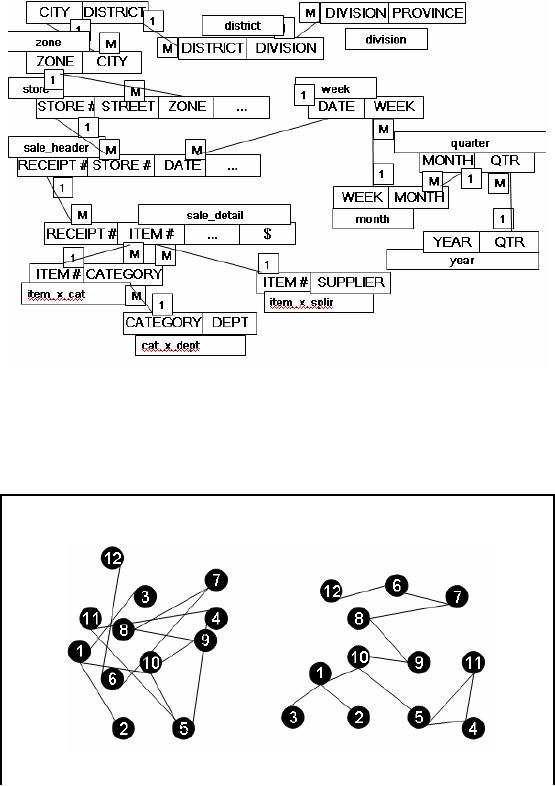
Having a
close look at the diagram,
it reveals that a separate
table has been maintained to
store
different
entities resulting in a complex overall
model. Probing the model to get
informative
insight about
data is not straightforward. For
example, we can not tell by
looking at the model
the
relative
importance of tables. We can
not know the table
sizes (though we can guess by
looking at
just
headers), and most importantly we
can not tell about
business dimensions by just
looking at
the
table headers i.e. which
tables contain business
measurements of the business ,
which tables
contain
the static descriptive data
and so on.
�
Many topologies
for the same ER diagram, all
appearing different.
� Very hard
to visualize and
remember.
�
A large number
of possible connections to any
two (or more) tables
Figure-13.1:
Need for DM: Un-answered
Qs
91

Even
for the simple retail
example, there are more
than a dozen tables that
are linked together
by
puzzling
spaghetti of links; and this is
just the beginning. This problem is
further complicated by
the fact
that there can be numerous
(actually exponentially large) topologies for
the same system
created by
different people, and
re-orienting makes them
better (or worse).
The problem
becomes even more complex
for the ER model for an
enterprise, which has
hundreds of
logical entities, and for a
high end ERP systems
for a large multinational there
could
be literally
thousands of such entities.
Each of these entities
typically translates into a
physical
table when
the database is implemented.
Making sense of this "mess"
is almost impossible,
communicating it to
someone even more
difficult.
Need
for DM: The
Paradox
�
The
Paradox: Trying to
make information accessible
using tables resulted in an
inability
to query it
efficiently!
�
ER and
Normalization result in large number of
tables which are:
� Hard to
understand by the users (DB
programmers)
�
Hard to navigate
optimally by DBMS
software
�
Real
value of ER is in using tables
individually or in pairs
�
Too
complex for queries that
span multiple tables with a
large number of records
However,
there is a paradox! In the fervor to
make OLTP systems fast
and efficient, the
designers
lost
sight of the original, most
important goal i.e. querying the
databases to retrieve
data/information. Thus
this defeats the purpose as
follows:
�
Due to
the sheer complexity of the ER graph,
end users cannot understand
or remember
an ER model,
and as a consequence cannot navigate an
ER model. There is no graphical
user interface
(GUI) that takes a general
ER model and makes it usable to
end users,
because
this tends to be an NP-Complete
problem.
�
ER models
are typically chaotic and
"random", hence software cannot
usefully query
them.
Cost-based optimizers that attempt to do
this are infamous for making
the wrong
choices,
and disastrous performance
consequences.
�
And
finally, use of the ER
modeling technique defeats
the basic attraction of
data
warehousing,
namely intuitive and high
-performance retrieval of data.
92
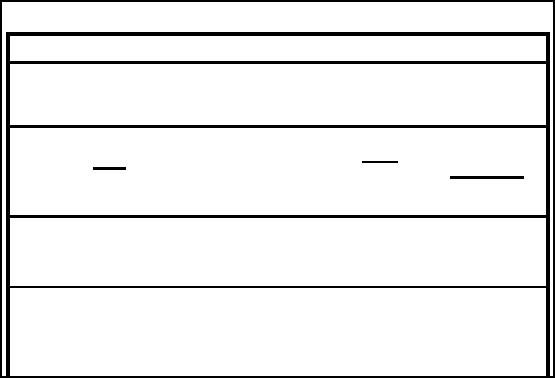
ER vs.
DM
ER
DM
Constituted to
optimize DSS query
Constituted to
optimize OLTP performance.
performance.
Models the
macro relationships among
data
Models the micro
relationships among
data
elements
with an overall
deterministic
elements.
strategy.
All
dimensions serve as equal
entry points to
A wild
variability of the structure of ER
models.
the fact
table.
Very
vulnerable to changes in the
user's querying Changes in user querying
habits can be catered
habits,
because such schemas are
asymmetrical. by automatic SQL
generators.
Table
13.1: ER vs. DM
1- ER models
are constituted to (a)
remove redundancy from the
data model, (b)
facilitate
retrieval of
individual records h aving
certain critical identifiers, and (c)
therefore, optimize On -
line
Transaction Processing (OLTP)
performance.
2- ER modeling
does not really model a
business; rather, it models
the micro relationships
among
data
elements. ER modeling does not have
"business rules," it has
"data rules."
3- The
wild variability of the
structure of ER models means
that each data warehouse
needs
custom,
handwritten and tuned SQL. It
also means that each
schema, once it is tuned, is
very
vulnerable to
changes in the user's querying
habits, because such schemas
are asymmetrical.
===============================================================
1-In
DM, a model of tables and
relations is constituted with
the purpose of optimizing
decision
support query
performance in relational databases,
relative to a measurement or set
of
measurements of
the outcome(s) of the
business process being
modeled.
2-Even a
big suite of dimensional models
has an overall deterministic strategy
for evaluating
every
possible query, even those
crossing many fact
tables.
3-All
dimensions serve as equal entry
points into the fact table.
Changes in users' querying
habits
don't change
the structure of the SQL or
the standard ways of
measuring and
controlling
performance.
93

How to
simplify an ER data
model?
�
Two general
methods:
�
D
e-Normalization
�
Dimensional
Modeling (DM)
The
shortcomings of ER modeling did not
unnoticed. Since the beginning of
the relational
database
revolution, many DB designers tried to
deliver the design data to
end users as ra ther
look-alike
"simpler designs with a "dimensional"
i.e. ease of understanding
and performance as
the
highest goals. There are
actually two ways of "simplifying"
the ER model i.e. (i) De
-
normalization
and (ii) Dimensional
Modeling.
What is
DM?...
�
A simpler
logical model optimized for decision
support.
�
Inherently
dimensional in nature, with a single
central fact table and a set
of smaller
dimensional
tables.
�
Multi-part
key for the fact
table
�
Dimensional
tables with a single-part
PK.
�
Keys
are usually system
generated.
�
�
Results in a
star like structure, called
star schema or star
join.
�
All
relationships mandatory
M-1.
�
Single path
between any two
levels.
�
Supports
ROLAP operations.
DM is a logical
design technique that seeks
to present the data in a
standard, instinctive structure
that
supports high-performance and ease of
understanding. It is inherently dimensional in
nature,
and it
does adhere to the relational
model, but with some important
restrictions. Such as,
every
dimensional model is
composed of one "central"
table with a multipart key,
called the fact
table,
and a
set of smaller tables called dimension
tables. Each dimension table has a
single-part
primary
key that corresponds exactly
to one of the components of
the multipart key in the
fact
table.
This results in a characteristic
"star -like" structure or
star schema.
DM is a logical
design technique that seeks
to present the data in a
standard, instinctive
structure
that
supports high-performance and
ease of understanding. It is inherently
dimensional in nature,
and it
does adhere to the relational
model, but with some important
restrictions. Such as,
every
dimensional model is
composed of one "central"
table with a multipart key,
called the fact
table,
and a
set of smaller tables called dimension
tables. Each dimension table has a
single-part
primary
key that corresponds exactly
to one of the components of
the multipart key in the
fact
table.
This results in a characteristic
"star -like" structure or
star schema.
94
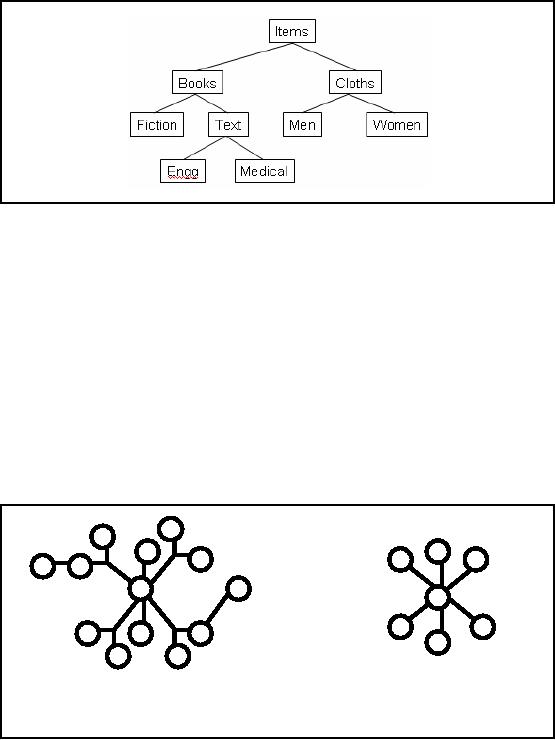
Dimensions
have Hierarchies
Analysts
tend to look at the data
through dimension at a particular "level" in
the hierarchy
Figure-13.2:
Dimensions have
Hierarchies
The
foundation for design in
this environment is through use of
dimensional modeling techniques
which
focus on the concepts of "facts"
and "dimensions" for organizing
data.
Facts
are the quantities or numerical
measures (e.g., sales $)
that we can count and
the most
useful being
those that are additive.
The most useful facts in a fact
table are numeric and
additive.
Additive
nature of facts is important, because
data warehouse applications
almost never retrieve
a
single
record form the fact table;
instead, they fetch back
hundreds, thousands, or even millions
of
these
records at a time, and the
only useful thing to do with
so many records is to add
them up.
Example,
what is
the average salary of
customers who's age > 35
and experience more
than
5
years?
Dimensions
are the descriptive textual
information and the source
of interesting constraints on
how we
filter/report on the quantities
(e.g., by geography, product,
date, etc.). For the
DM
shown, we
constrain on the clothing
department via the Dept attribute in
the Product table. It
should be
obvious that the power of
the database shown is
proportional to the quality
and depth of
the dimension
tables.
The
two Schemas
Star
Snow-flake
Figure-13.3:
The two schemas
95
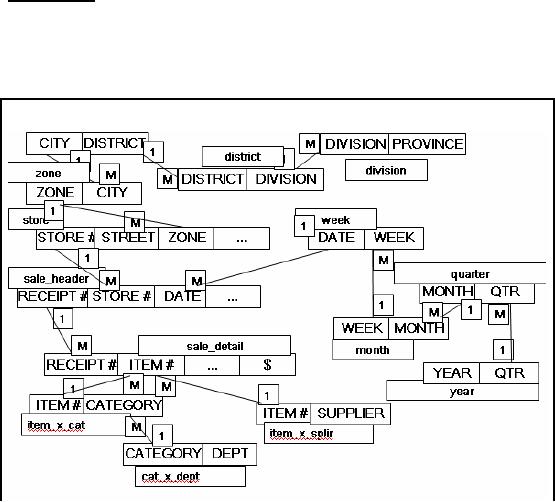
Fig-13.3
shows the snow-flake schema
i.e. with multiple
hierarchies that is typical of an OLTP
or
MIS
system. The other is a simplified
star schema with no
hierarchies and a central
node. Such
schemas
are typical of Data
Warehouses.
Snowflake
Schema: Sometimes a
pure star schema might
suffer performance problems. This
can
occur when a
de-normalized dimension table
becomes very large and
penalizes the star
join
operation.
Conversely, sometimes a small outer-level
dimension table does not
incur a significant
join
cost because it can be
permanently stored in a memory
buffer. Furthermore, because a
star
structure
exists at the center of a snowflake, an
efficient star join can be
used to satisfy part of a
query.
Finally, some queries will
not access data from
outer-level dimension tables.
These queries
effectively
execute against a star
schema that contains smaller
dimension tables. There fore,
under
some
circumstances, a snowflake schema is more
efficient than a star
schema.
Star
Schema: A star
schema is generally considered to be the
most efficient design for
two
reasons.
First, a design with de-normalized
tables encounters fewer join
operations. Second,
most
optimizers are
smart enough to recognize a star
schema and generate access
plans that use
efficient
"star join" operations. It
has been established that a
"standard template" data
warehouse
query directly
maps to a star
schema.
"Simplified"
3NF (Retail)
Figure-13.4:
"Simplified" 3NF (Retail)
In Fig -13.4 a
(simplified) retail data model is shown
in the third normal form
representation keeps
each
level of a dimensional hierarchy in a separate
table (e.g., store, zone,
region or item,
96
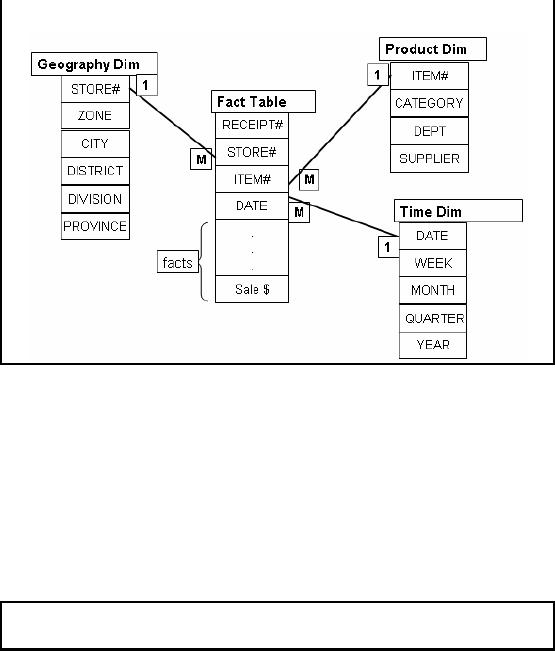
category,
department). The sale header
and detail information is also maintained
in two separate
tables.
Vastly
Simplified Star
Schema
Figure-13.5: Vastly
Simplified Star
Schema
The goal of a
star schema design is to
simplify the physical data
model so that RDBMS
optimizers
can exploit advanced indexing and
join techniques in a straightforward
manner, as
shown in Fig-13.5.
Some RDBMS products rely on
star schemas for performance
more than
others
(e.g., Re d Brick versus
Teradata).
The ultimate
goal of a star schema design is to put
into place a physical data
model capable of
very
high performance to support iterative
analysis adhering to an OLAP model of
data delivery.
Moreover,
SQL generation is vastly simplified for
front-end tools when the data is
highly
structured in
this way.
In some
cases, facts will also be
summarized along common dimensions of
analysis for additional
performance.
The
Benefit of Simplicity
Beauty
lies in close correspondence
with the business, evident
even to business
users.
The ultimate
goal of a star schema design is to put
into place a physical data
model capable of
very
high performance to support iterative
analysis adhering to an OLAP model of
data delivery.
Moreover,
SQL generation is vastly simplified
for front-end tools when the
data is highly
structured in
this way.
97

In some
cases, facts will also be
summarized along common dimensions of
analysis for additional
performance.
Features of
Star Schema
Dimens
ional hierarchies are
collapsed into a single
table for each dimension.
Loss of
information?
A single fact
table created with a single
header from the detail
records, resulting in:
�
A vastly
simplified physical data
model!
�
Fewer tables
(thousands of tab les in
some ERP systems).
�
Fewer joins resulting in
high performance.
�
Some requirement
of additional space.
By "flattening"
the information for each
dimension into a single
table and combining
header/detail
records, the physical data
model is vastly simplified. The
simplified data model of a
star
schema allows for straightforward
SQL generation and makes it
easier for RDBMS
optimizers
detect opportunities for "star
joins" as a means of efficient query
execution.
Notice that
star schema design is merely a specific
methodology for deploying the
pre-join de-
normalization
that we discussed earlier.
Quantifying
space requirement
Quantifying
use of additional space
using star schema
There are
about 10 million mobile phone
users in Pakistan.
Say
the top company has half of
them = 500,000
Number of days
in 1 year = 365
Number of calls
recorded each day = 250,000
(assumed)
Maximum
number of records in fact
table = 91 billion rows
Assuming a
relatively small header size
= 128 bytes
Fact
table storage used = 11 Tera
bytes
Average length
of city name = 8 characters ≈ 8
bytes
Total
number of cities with
telephone access = 170 (1
byte)
Space
used for city name in
fact table using Star = 8 x
0.091 = 0.728 TB
Space
used for city code using
snow-flake = 1x 0.091= 0.091 TB
Additional
space used ≈ 0.637 Tera
byte i.e. about
5.8%
By virtue of
flattening the dimensions, instead of
storing the city code, now
in the "flattened"
table
the name of the city will be
stored. There is a 1: 8 ratio
between the two-representations.
But
out of a header
size of 128, there has been
an addition of 7 more bytes i.e. an
increase in storage
space of
about 5%. This is not much,
if there are frequent
queries for which the
join has not been
eliminated.
98
Table of Contents:
- Need of Data Warehousing
- Why a DWH, Warehousing
- The Basic Concept of Data Warehousing
- Classical SDLC and DWH SDLC, CLDS, Online Transaction Processing
- Types of Data Warehouses: Financial, Telecommunication, Insurance, Human Resource
- Normalization: Anomalies, 1NF, 2NF, INSERT, UPDATE, DELETE
- De-Normalization: Balance between Normalization and De-Normalization
- DeNormalization Techniques: Splitting Tables, Horizontal splitting, Vertical Splitting, Pre-Joining Tables, Adding Redundant Columns, Derived Attributes
- Issues of De-Normalization: Storage, Performance, Maintenance, Ease-of-use
- Online Analytical Processing OLAP: DWH and OLAP, OLTP
- OLAP Implementations: MOLAP, ROLAP, HOLAP, DOLAP
- ROLAP: Relational Database, ROLAP cube, Issues
- Dimensional Modeling DM: ER modeling, The Paradox, ER vs. DM,
- Process of Dimensional Modeling: Four Step: Choose Business Process, Grain, Facts, Dimensions
- Issues of Dimensional Modeling: Additive vs Non-Additive facts, Classification of Aggregation Functions
- Extract Transform Load ETL: ETL Cycle, Processing, Data Extraction, Data Transformation
- Issues of ETL: Diversity in source systems and platforms
- Issues of ETL: legacy data, Web scrapping, data quality, ETL vs ELT
- ETL Detail: Data Cleansing: data scrubbing, Dirty Data, Lexical Errors, Irregularities, Integrity Constraint Violation, Duplication
- Data Duplication Elimination and BSN Method: Record linkage, Merge, purge, Entity reconciliation, List washing and data cleansing
- Introduction to Data Quality Management: Intrinsic, Realistic, Orr’s Laws of Data Quality, TQM
- DQM: Quantifying Data Quality: Free-of-error, Completeness, Consistency, Ratios
- Total DQM: TDQM in a DWH, Data Quality Management Process
- Need for Speed: Parallelism: Scalability, Terminology, Parallelization OLTP Vs DSS
- Need for Speed: Hardware Techniques: Data Parallelism Concept
- Conventional Indexing Techniques: Concept, Goals, Dense Index, Sparse Index
- Special Indexing Techniques: Inverted, Bit map, Cluster, Join indexes
- Join Techniques: Nested loop, Sort Merge, Hash based join
- Data mining (DM): Knowledge Discovery in Databases KDD
- Data Mining: CLASSIFICATION, ESTIMATION, PREDICTION, CLUSTERING,
- Data Structures, types of Data Mining, Min-Max Distance, One-way, K-Means Clustering
- DWH Lifecycle: Data-Driven, Goal-Driven, User-Driven Methodologies
- DWH Implementation: Goal Driven Approach
- DWH Implementation: Goal Driven Approach
- DWH Life Cycle: Pitfalls, Mistakes, Tips
- Course Project
- Contents of Project Reports
- Case Study: Agri-Data Warehouse
- Web Warehousing: Drawbacks of traditional web sear ches, web search, Web traffic record: Log files
- Web Warehousing: Issues, Time-contiguous Log Entries, Transient Cookies, SSL, session ID Ping-pong, Persistent Cookies
- Data Transfer Service (DTS)
- Lab Data Set: Multi -Campus University
- Extracting Data Using Wizard
- Data Profiling